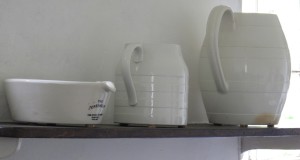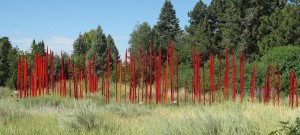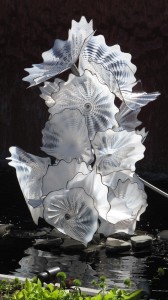The Denver Botanic Gardens does an art installation every year in late spring or early summer. One year it was Chapunga – the work of a number of Zimbabwean sculptors. Another year were the bronzes of Allan Houser. Henry Moore’s large and amazing pieces were featured in 2012. This year, the installation that is creating such a buzz highlights Dale Chihuly’s blown glass. Schedules being what they are, yesterday was the first time my husband and I got to see the glass on site…although we have heard both raves and pans since it arrived.
Personally, I found it a challenging experience. The stone, marble, and bronze of the earlier exhibits have always seemed to rise quite naturally from the soil and grass and water of the Gardens. The pieces fit into the landscape, beckoning the visitor to pause and reflect awhile…or simply to stop and rest with a companion presence. The environment for each piece seemed carefully chosen both to frame the piece and to enhance the surroundings. There was a sense of continuity and cohesion.
Chihuly’s pieces – and let me say that I adore Chihuly’s work and visit it whenever I am somewhere that has a piece in a local museum – were frequently startling in their placement. They were not what I would call cohesive or complementary at all. They took over most of the settings and insisted on attention. The environment faded into the background. There were places where this worked brilliantly and the conversation between piece and garden was lively and provocative. There were other places where I wasn’t sure – the art and the landscape seemed to rub one another a little raw. And then there were pieces that looked like they were meant for some other life or garden and just ended up here by mistake.
Hold that thought.
By coincidence, when we left the Gardens, we ended up at an estate sale (actually three estate sales in sequence). I am looking for a new sewing desk and storage cabinets for my studio and estate sales can be a treasure trove of reasonably priced furniture. These sales are usually held when someone dies and the house and its contents need to be disposed of. So, walking from room to room is like looking at a snapshot or series of snapshots of a life you do not know in any other way because you never met this person alive. All you have are the objects she or he has left behind from which to glean an idea of the values she held, the experiences he had, the relationships that delighted them. For my husband and me (whose vocations are about the high and low moments of human life; about observing the way people respond to love, stress, hope, fear, pain, accomplishment; about listening to stories), estate sales are wondrous events. They are intriguing mysteries to solve, but also a way of bearing witness to the meaning someone brought to and received from their time in this here and now.
Some sales are incredibly cohesive. They are not necessarily all one style (Art Deco, 1950s, rustic), but there is a sense of wholeness in the combination of articles. There is little question who the person was and what she or he valued. You may like what you perceive or dislike it, but you sense clarity. Other sales contain odd bits, things you notice right away and wonder, “What was that about?” What life-changing experience caused the shift that brought this collection of African masks to the wall of this Early American house? Or you suspect unfinished grief in a home with only men’s clothing – and a room filled with unfinished hand work projects from ten or twenty years ago (half-embroidered pillowcases, a stack of quilt blocks, balls of yarn with knitting needles still in place). And then there are the sales you leave completely baffled: there are 10 or 15 ‘collections’ of four or five similar items (Toby mugs, beanie babies, tin trays, blown glass horses) but no two collections seem related and no single collection seems to have meant enough for the person to be fully invested. The art on the walls has no discernible theme or style. The linens have no predominant color or pattern. The dishware is leftovers from three or four designs.
 So, as I prepared for bed last night, I found myself pondering the landscapes of the soul and how (even, if!) we attend to landscaping our inner beings. Chihuly’s extraordinary glass pieces are set in a changing landscape – gardens, after all, change across the seasons and what is a background of riotous color right now, may be simply green in another month. What is a lush surrounding of green now, may ripen and dry to gold or brown as the full heat of summer hits.
So, as I prepared for bed last night, I found myself pondering the landscapes of the soul and how (even, if!) we attend to landscaping our inner beings. Chihuly’s extraordinary glass pieces are set in a changing landscape – gardens, after all, change across the seasons and what is a background of riotous color right now, may be simply green in another month. What is a lush surrounding of green now, may ripen and dry to gold or brown as the full heat of summer hits.
The inner gardens of our spirits and souls are also set in a changing landscape of experiences and the passing of time. But do we see this as an opportunity for focused pruning or planting, for rearranging, for weeding? Do we bring intention and choice to the change, or do we ignore it or deny it? What makes some landscapes, some environments, cohesive (complementary, graceful, whole) and some puzzling, and some simply chaotic?
There comes a point when an artist releases a work and she or he has no more control over it: it either speaks to the viewer or it doesn’t. It means something or it doesn’t. The meaning resonates or it doesn’t. An estate sale is a life released out of a person’s control. What is left either reflects the person’s inner cohesion or it reflects a dissonance or it reflects an inner anarchy.
I woke this morning and walked through my home and looked at the objects that reside with me with new eyes. I am pondering my own inner landscape and whether my outward choices reflect the person I want to be, or if they reflect some other person from some other time…or if they reveal something about me that I would do well to pay attention to.
How about you?
–Andrea
Text © 2014, Andrea La Sonde Anastos
Red Reeds and Persian Tower © Dale Chihuly
Photos © 2014, Immram Chara, LLC
[The pottery pitcher photo is available as a special order card or print through my Etsy shop.]

